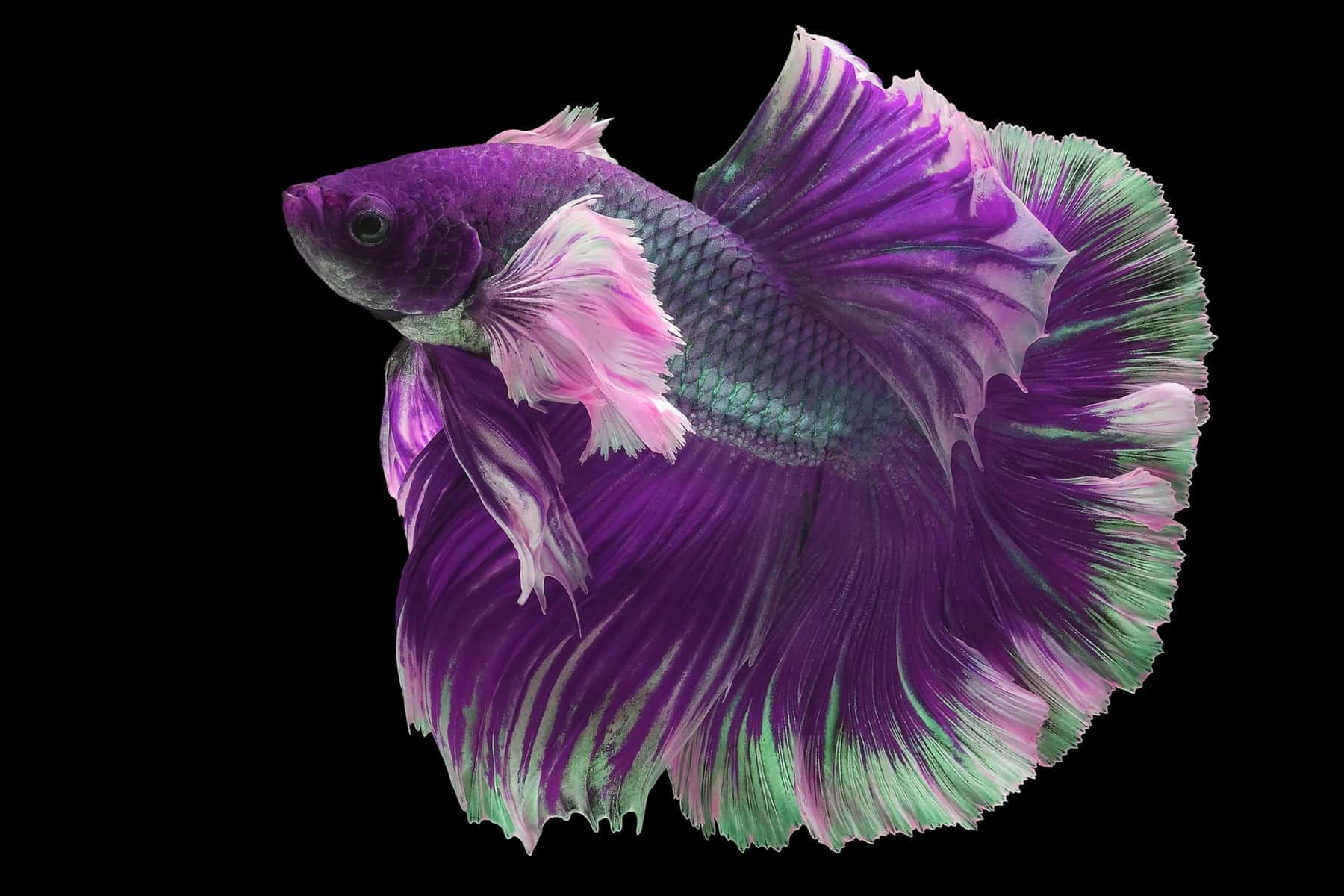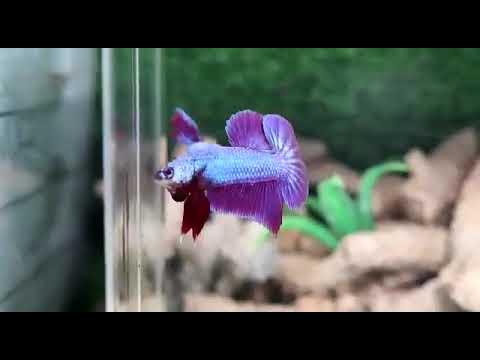Originally posted on May 10, 2023 @ 6:00 am
Last Updated on 7 months by admin
If you’re looking for a unique and captivating pet, the purple betta fish might just be the perfect fit for you. With its stunning coloration and graceful movements, this fish has become a popular choice for fish enthusiasts all over the world.
The purple betta fish, also known as Siamese fighting fish, is a species of freshwater fish native to Southeast Asia. Its striking purple hue is a result of selective breeding, making it a prized possession for many aquarium hobbyists. But there’s more to this fish than just its beauty. In this article, we’ll explore the fascinating world of the purple betta fish and what makes it such an alluring addition to any aquarium.

The Alluring Purple Betta Fish: A Guide to Understanding This Beautiful Species
Betta fish are one of the most popular species of fish kept in home aquariums. Known for their vibrant colors and lively personalities, these fish make excellent pets for both beginners and experienced fish keepers alike. One of the most fascinating colors of betta fish is the purple variety, with its deep, rich hues that are sure to capture anyone’s attention. In this guide, we’ll take a closer look at the alluring purple betta fish and explore its unique characteristics that make it a standout in the world of aquarium fish.
Appearance
The purple betta fish is a stunning creature with a vibrant, deep purple color that shimmers in the light. This color is created by a pigment called chromatophores, which give the fish its distinctive hue. The fish’s iridescent scales reflect the light in different ways, making the purple color appear to change and shift depending on the angle you view it from.
In addition to their striking color, purple betta fish are also known for their long, flowing fins and tails. These fins are an important part of the fish’s defense mechanism, as they can be flared out to make the fish appear larger and more intimidating to predators.
Behavior
Betta fish are known for their active and playful personalities, and purple bettas are no exception. These fish are curious and love to explore their surroundings, swimming around their tank and investigating anything that catches their eye. They are also known for their territorial nature, and it’s important to provide them with plenty of space and hiding places to prevent them from becoming aggressive towards other fish in the tank.
One of the most fascinating behaviors of betta fish is their ability to create bubble nests. Male bettas will build a nest of bubbles on the surface of the water, which they use to incubate their eggs. This behavior is unique to bettas and is a fascinating sight to see.
Diet
Like all fish, purple bettas require a balanced and nutritious diet to thrive. Their diet should consist of a variety of foods, including high-quality betta pellets, frozen or live food such as brine shrimp or bloodworms, and occasional treats like freeze-dried shrimp or krill. It’s important not to overfeed your betta, as this can lead to health problems such as bloating and constipation.
Care
Caring for a purple betta fish is relatively easy, as long as you provide them with the right environment and conditions. They require a tank that is at least 5 gallons in size, with a filter and heater to maintain a stable water temperature and keep the water clean. It’s important to perform regular water changes to keep the water parameters healthy for your fish.
In addition to providing them with a clean and spacious tank, it’s important to give your betta plenty of hiding places and decorations to explore. Betta fish love to have places to hide and explore, and adding plants, rocks, and other decorations to the tank can help keep them happy and healthy.
Benefits of Owning a Purple Betta Fish
Owning a purple betta fish can bring many benefits to your life. These fish are fascinating to watch and can provide a sense of calm and relaxation as you observe their graceful movements and behaviors. They are also relatively low-maintenance compared to other species of fish, making them an ideal pet for busy individuals or those new to fish keeping.
In addition to their beauty and personality, betta fish are also believed to have some health benefits. Watching fish swim has been shown to reduce stress and lower blood pressure, and betta fish are often used in therapy and meditation practices for their calming effects.
Purple Betta Fish vs Other Betta Fish
While all betta fish share many of the same traits and characteristics, there are some differences between the various color varieties. Purple bettas are known for their deep, rich color and long, flowing fins, while other varieties such as red or blue bettas may have shorter fins or a different shade of color.
It’s important to note that betta fish should never be kept in the same tank as other bettas, regardless of their color or variety. Betta fish are highly territorial and will become aggressive towards other fish, which can lead to injury or even death.
Conclusion
The alluring purple betta fish is a unique and beautiful species that is sure to capture your heart. With its vibrant color, long flowing fins, and playful personality, this fish makes an excellent pet for anyone looking to add some beauty and life to their home aquarium. By providing them with the right care and environment, you can enjoy the beauty and wonder of these fascinating creatures for years to come.
Frequently Asked Questions
Discover the beauty of the alluring purple betta fish with these frequently asked questions. Learn more about their habitat, diet, and how to take care of them.
What is a purple betta fish?
A purple betta fish is a type of Siamese fighting fish that has a unique coloration of purple and blue. They are also known as betta splendens and are popular among fish enthusiasts because of their vibrant colors and long, flowing fins.
These fish are native to Southeast Asia and are typically found in shallow waters such as rice paddies, canals, and swamps. They are often kept as pets in aquariums or fish bowls and require minimal care as long as their habitat is well-maintained.
What do purple betta fish eat?
Purple betta fish are carnivorous, which means they primarily eat meat-based foods. They can be fed a variety of live or frozen foods such as bloodworms, brine shrimp, and daphnia. They can also be fed pellet or flake food specifically formulated for betta fish.
It’s important to avoid overfeeding your betta fish as this can lead to health problems such as bloating and swim bladder disease. A good feeding schedule is once or twice a day, with only as much food as they can consume within a few minutes.
How do you take care of a purple betta fish?
To take care of a purple betta fish, you will need a suitable habitat such as a fish tank or bowl with a capacity of at least 2.5 gallons. The water should be kept at a temperature between 74-82 degrees Fahrenheit and the pH level should be between 6.5-7.5.
It’s important to keep the water clean by doing regular water changes and maintaining a filtration system. You should also provide hiding spots and decorations for your betta fish to explore and feel secure. Lastly, make sure to feed your betta fish a balanced diet and avoid overfeeding.
Do purple betta fish need a filter?
Yes, purple betta fish do need a filter in their habitat. A filter helps to maintain the water quality by removing any excess food, waste, or debris. Without a filter, the water can quickly become dirty and toxic, which can lead to health problems for your betta fish.
There are various types of filters available for aquariums and fish bowls, such as hang-on-back filters, sponge filters, and internal filters. It’s important to choose the right type of filter based on the size of your betta fish’s habitat and their specific needs.
Can you keep multiple purple betta fish together?
No, it’s not recommended to keep multiple purple betta fish together in the same habitat. Betta fish are known for their aggressive behavior, especially towards their own kind. Keeping multiple betta fish together can lead to fights and injuries, and can also cause stress and health problems.
If you want to keep multiple betta fish, you should provide separate habitats for each fish. It’s important to choose a habitat with a capacity of at least 2.5 gallons and to maintain proper water conditions and filtration for each habitat.

RARE purple betta fish! #betta #aquarium #bettafish
In conclusion, the purple betta fish is a stunning and captivating creature that is sure to catch the eye of any fish enthusiast. Its vibrant colors and unique personality make it a popular choice among fish keepers around the world.
Not only is the purple betta fish aesthetically pleasing, but it is also relatively easy to care for. With a few basic requirements, such as a properly sized tank and a balanced diet, this fish can thrive in a home aquarium.
Overall, the purple betta fish is a wonderful addition to any aquarium. Its beauty and ease of care make it a great choice for both experienced and novice fish keepers. So why not add a touch of allure to your tank with a stunning purple betta fish?
